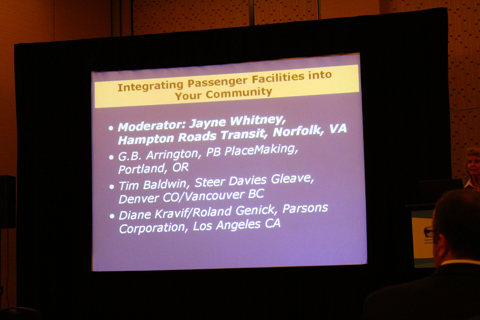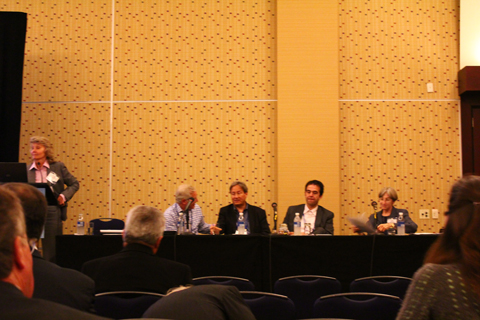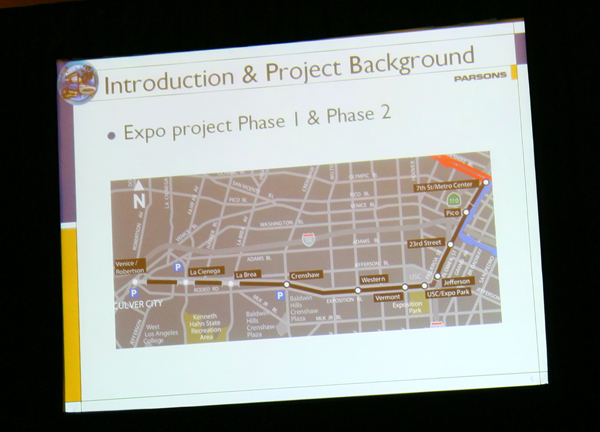APTA Rail 2010: Integrating Passenger Facilities into the Community
APTA Rail 2010: Integrating Passenger Facilities into the Community

If you didn’t know, TransLink is hosting the 2010 American Public Transportation Association (APTA) rail conference this week! See the APTA Rail 2010 category for more posts.
The conference is pretty much over today, by the way, but I still have a few posts to put up!
“Integrating Passenger Facilities into the Community” was the last session I attended on Tuesday: it talked about rail station design and its potential to transform communities. Excerpt from the session description:
What are the opportunities to serve as gateways to the community? How do they connect to the regional transit system? Hear the latest on station area planning and how stations fit into the surrounding community and offer potential for transit-oriented development.
Here are my summaries from the three presentations during this session! Again, feel free to offer corrections: I only wrote what I heard and certainly may have erred here and there.
High-Speed Rail: A Catalyst For Community Building

G.B. Arrington, co-chair, APTA Land Use and Economic Development Subcommittee, and principal practice leader, Parsons Brinckerhoff, Portland, OR
G.B. works with PB PlaceMaking, the community-building/transit-oriented development consultancy from Parsons Brinckerhoff. His talk stressed said that high-speed rail is a huge opportunity and tool for community building!
Lessons from high-speed rail systems abroad show that these projects are enormous, and they can change a city, if it wants to change. (Lille was one of the slide examples.) Plan for a station as a real destination for people—make sure it has business and service-oriented travel, not just commuter trips. It takes leadership!
G.B. said that there is much to “unlearn” about transit while building high-speed rail too: stations are enormous (1,320’ long in the California high speed rail project!) and will take very high volumes (California expects 9 million annually).
He likened the coming of high-speed rail to the coming of the transcontinental railway, and planning must reflect that. The stations can become a city’s new most important place. It’s the “front door” for your city!
Some guidelines mentioned: An isolated station has no value: the value is station connections to pedestrians, transit, and cars. Your transit oriented development zone should be active 18-24 hours of the day. Designing for a pedestrian scale is important: don’t let parking dominate your station, and make it compact and invisible.
He also said that planning for transit oriented development involves three things: 1) make transit work; 2) make a place; 3) connect to community. You can do them in any order, and you’ll need partners to make this work, because there’s no one authority responsible for all of them.
Uber-Tod Planning And High-Speed Rail
Tim Baldwin, AICP, associate, Steer Davies Gleave, Denver, CO
Tim works with Steer Davies Gleave (SDG), an international transportation planning company headquartered in London UK.
Tim’s talk also discussed high-speed rail. His first point was that many small and midsized cities that don’t have any current rail presence are now on the alignments for big high-speed rail projects. So the question is now, can these small and midsized cities build transit-oriented developments around their new high-speed rail stations, without mass transit and large populations? He thought yes.
He said, however, that these types of stations would likely follow different transit-oriented development rules than traditional models of walkable neighbourhoods. These stations would be more akin to airports, with a focus on hotels, office use, parking, and less residential space.
He said this is something people should be thinking about now, and that several groups are already thinking about it: the Florida department of transportation is doing so, so is UC Berkeley in the Stockton area, and so is the Transit Coalition in the Temecula area of California.
Conclusions were: be sensitive to local contexts, local markets, and to those impacted but who may not benefit from the rail line.
Chasing The Win-Win: Integration Of The Mid-City/Exposition LRT Project With A Transit-Oriented Development

Diane Kravif, P.E.*, principal project manager, Parsons Corporation, Los Angeles, CA
Roland Genick, RA, AICP*, chief architect, Parsons Corporation, Los Angeles, CA
Diane and Roland work with Parsons, another global engineering firm headquartered in California.
Their talk focused on Venice/Robertson Station on the Expo Line in Los Angeles. The station is the terminus station for Phase 1 of the Expo Line construction, but after Phase 2 is complete, it’s going to be just another middle station on the Line.
It was meant to be a target for transit-oriented development, but due to the phased nature of the construction process, it can only be done in stages. The station also sat on the edge of two cities, Culver City and Los Angeles, and neither one had enough land alone to do something useful with: so partnerships were needed.
So Diane and Roland talked about building a temporary parking lot on the north side to handle cars anticipated while Venice/Robertson remains a terminus station, but the expectation is to change that over into a pedestrian-focused realm in the future.
Their conclusions were to remain flexible, focus on the passenger visiting experience, consider phasing carefully, and be realistic. Transit-oriented development involves a mix of jurisdictions, transit modes, the site, and the development climate.






Here’s question on high-speed rail…. In the past I didn’t find the Amtrak departure frequency practical…. 6:45am and 5:45pm. Now I see the morning trip is $50 for Canadians, but $38 for the evening trip for Americans. This just doesn’t sound fair.
South of the Fraser communities would be wise to be fully plugged into discussions on the proposed upgrade to high speed rail along the Cascadia (i.e. including Portland, Seattle, Vancouver) corridor. If the century-old railway bridge near the Pattullo doesn’t get replaced, the northern terminus of HSR may well be Surrey Central.
I’m curious on the 2nd leg where they had to go from Broadway & Commercial to Main on the 99. Did everyone actually get on. Or were there many pass byes :)
I’d actually be more shocked if everyone got on.
Paul C: We all got on! Squishy though. We tried very hard to stay on the same vehicles, though there were contingency plans if we did get separated. (PS: I think your comment was meant for a different post?)